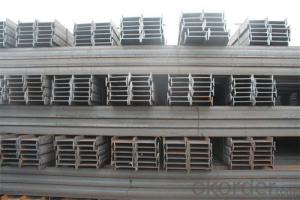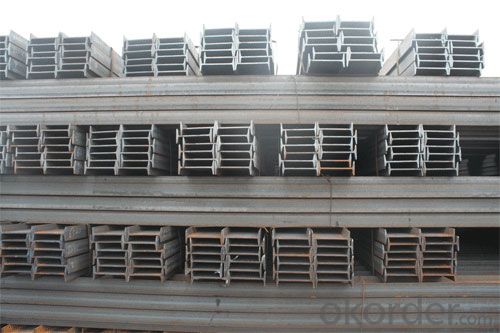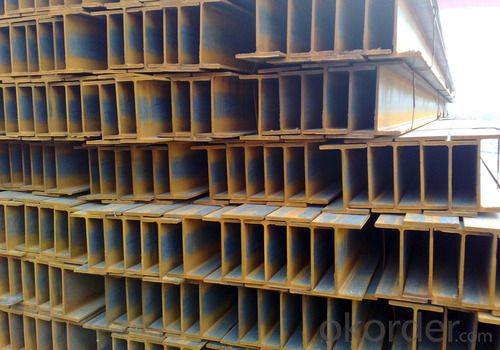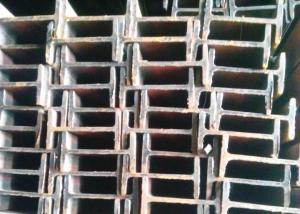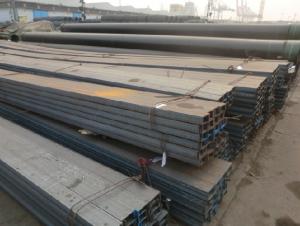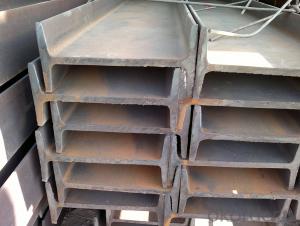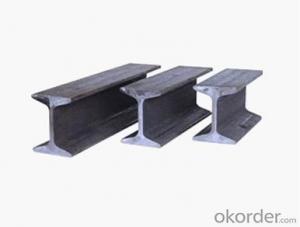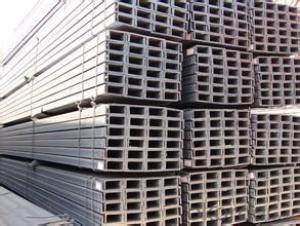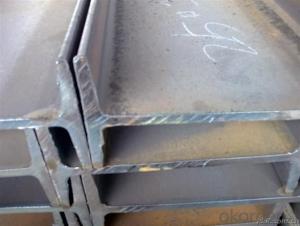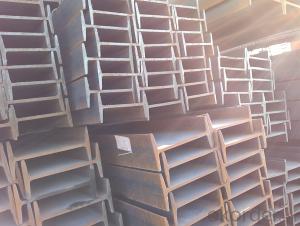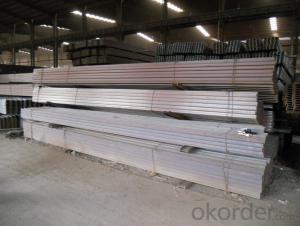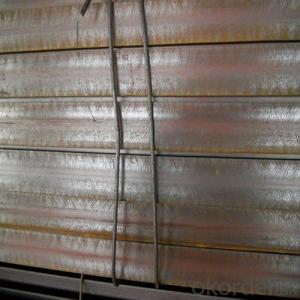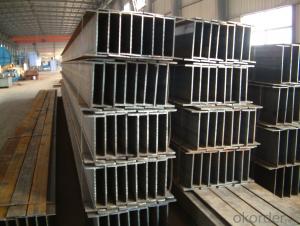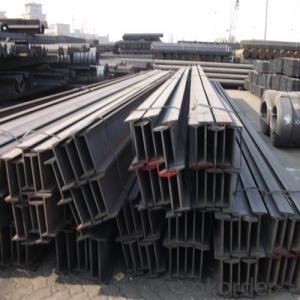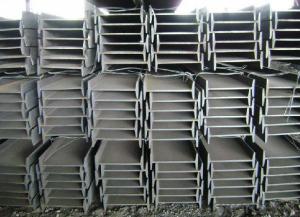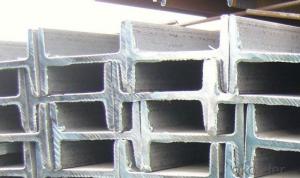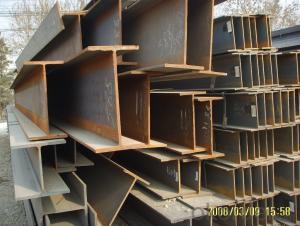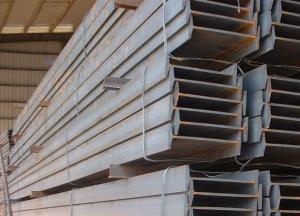High grade hot rolled H-section steel(Q235)
- Loading Port:
- Tianjin
- Payment Terms:
- TT OR LC
- Min Order Qty:
- 100 m.t.
- Supply Capability:
- 10000 m.t./month
OKorder Service Pledge
OKorder Financial Service
You Might Also Like
I-steel beam (also known as English name I Beam), is the section shape of strip steel i-beam.I-steel divides ordinary I-beam and light I-beam, H type steel three. Is the type of groove shaped steel section shape.
Introduction
I-steel beam (also known as English name I Beam), is an H-shaped steel section. I-steeldivides ordinary I-beam and light I-beam, H type steel three. The I-shaped steel is widely used in various building structures, bridges, vehicles, bracket, machinery etc..
I-beam
The reason of ordinary I-beam wing root and light I-beam to the edge of the progressively thinner, has a certain angle, the ordinary I-beam and light I-beam model is the Arabia digitalwith the waist high cm number to represent, web, flange thickness and width of flange to the different specifications to waist high (H) x width (leg b) * waist thickness (d) without number representation, such as "general 160 x 88 x 6", namely said waist high of 160 mm 88 mm in width, legs, waist thickness of 6 mm is ordinary i-beam. / "light 160 x 81 x 5", namely said waistheight 160 mm, width of 81 mm legs, light I-beam waist thickness is 5 mm. Ordinary I-beamspecifications are available models said, type representation of waist high cm, such asgeneral 16#. Waist high same I-steel, if there are several different wide legs and waist thick,need to add a B C to be the difference in the types of the right, such as general 32#a, 32#b,32#c etc.. Hot rolled ordinary I-beam specifications for 10-63#. Hot rolled ordinary I-beamspecifications of both sides of supply and demand supply for 12-55# protocol.
Ordinary steel
The basic difference
I-beam are divided into ordinary I-beam, light I-beam and H type steel three.
Ordinary I-beam, light I-beam flanges on the web is variable cross section of thick, outer thin;H type steel: HW HM HN HEA HEB flange HEM I-beam is uniform
Ordinary I-beam, light I-beam has formed the national standard, the common 10# I-beamequivalent to the international I100 (such as the 10# channel also equivalent to channel(U100) for countries to implement different standards, resulting in subtle differences in their specifications)
H sections are also called the wide flange steel, HW HM HN derived from the European standard, HEB is the German standard I-beam, where HW, HN I-steel has been widely used in our country and production. HEA HEB HEM seen in many German design will, in the domestic market is also very difficult to buy. In the domestic steel structure engineering, if less, you can use the other specifications of steel plate welding assembled. And a large quantity of words,usually consider the use of mechanical properties and equivalent HW, HN type steel instead of.
HW I-beam is mainly used for reinforced concrete frame column steel column, also known asreinforced steel column; in the steel structure is mainly used for the column
HM type steel height and width of flange is roughly 1.33~~1.75 used for steel frame columnsin frame structure under dynamic load is used for the main frame beam in steel structure; for example: equipment platform
HN type steel height and flange width ratio is greater than or equal to 2; mainly used for beam
Use ordinary I-beam equivalent to HN steel;
The I-shaped steel whether ordinary or light, because the section size are relatively high,narrow, so the moment of inertia of the cross-section of two spindle difference, therefore, can only be used directly in the web plane bending component or its component lattice stress components. The axial compression member or in the perpendicular to the web plane and curved components are not used, thus in their application range is limited.
The H steel is efficient and economic cutting surface profile (there are other cold-formed steel, steel etc.), owing to the section shape is reasonable, they can make the steel higher effectiveness, improve the bearing capacity. Different from the ordinary I-shaped flange type H steel was widened, and the internal and external surface is usually parallel, which can facilitate the connection with high strength bolts and other components. Its size to form a series of reasonable, model complete, easy to use design.
The scope of application
Ordinary I-beam, light I-beam, because the section size are relatively high, narrow, so themoment of inertia of the cross-section of two main sleeve difference, thus in their applicationrange is limited. The I-steel should be based on the requirements of design drawings for choice.
The size design
H steel is efficient and economic cutting surface of steel (there are other cold-formed steel,steel etc.), owing to the section shape is reasonable, they can make the steel higher effectiveness, improve load ability. Different from the ordinary I-beam is flange type H steelwas widened, and the inner and the outer surface is usually parallel, which can facilitate theconnection with high strength bolts and other components. The composition of a reasonablesize, model complete, easy to use design.
In structure design, selection of I-beam should be based on its mechanical properties,chemical properties, weldability, structure size and the reasonable choice of the I-beam touse.
Welding process
Flange type H steel are of equal thickness, a rolling section, there are composite section is composed of 3 blocks of plate welding composition. Ordinary I-beam are rolling section,because of the production process is poor, the flange edge 1:10 slope. H type steel rolling is different from ordinary I-beam with only one set of horizontal roll, because of its wide flangeand no inclination (or slope is very small), so it will be a group of vertical roll at the same timerolling, therefore, the rolling technology and equipment than the conventional mill complex.The maximum rolling H steel of domestic production can be the height of 800mm, more thanonly welding composite section.
- Q: Can steel I-beams be used in high-temperature or fire-resistant applications?
- Steel I-beams can be used in high-temperature or fire-resistant applications to some extent. Steel is known for its high melting point and structural strength, making it a suitable choice for construction materials in various settings. However, it is important to consider the specific requirements and limitations when using steel I-beams in such applications. In high-temperature environments, steel I-beams can withstand elevated temperatures up to a certain threshold. The exact temperature limit depends on the type and grade of steel used. For example, regular carbon steel can generally withstand temperatures up to around 600-700 degrees Celsius (1112-1292 degrees Fahrenheit) before it begins to lose its structural integrity. However, it is crucial to consult with structural engineers and follow building codes and regulations to ensure safe and effective usage in high-temperature environments. When it comes to fire-resistant applications, steel I-beams can provide a certain level of fire protection. Steel is inherently fire-resistant as it does not burn or contribute to the spread of flames. However, in prolonged exposure to high temperatures, steel can eventually lose its strength and structural integrity. To enhance fire-resistant properties, additional measures such as fireproof coatings or encapsulation with fire-resistant materials may be necessary. These measures can help delay the onset of structural failure and provide additional time for evacuation or firefighting efforts. It is important to note that in extreme fire conditions, steel I-beams can still deform and weaken, potentially leading to structural collapse. Therefore, it is crucial to design and implement fire protection strategies that consider the specific fire resistance requirements of the application, ensuring the safety of occupants and the structural stability of the building. In summary, while steel I-beams can be used in high-temperature or fire-resistant applications, careful consideration of the specific requirements and limitations is necessary. Consulting with experts and following building codes and regulations are essential to ensure the safe and effective usage of steel I-beams in these environments.
- Q: How do you inspect steel I-beams for defects?
- Inspecting steel I-beams for defects involves a systematic approach to ensure the structural integrity and safety of the beams. Here are the steps typically followed in inspecting steel I-beams for defects: 1. Visual Inspection: Begin by visually examining the entire surface of the steel I-beams. Look for any signs of cracks, corrosion, or damages such as deformations, dents, or buckling. Pay special attention to areas where there may be joints or connections, as these are more prone to defects. 2. Non-Destructive Testing (NDT): Utilize non-destructive testing methods to identify defects that may not be visible to the naked eye. Common NDT methods include ultrasonic testing (UT), magnetic particle testing (MT), liquid penetrant testing (PT), and radiographic testing (RT). These techniques help detect internal flaws, cracks, and other defects that could compromise the structural integrity of the I-beams. 3. Ultrasonic Testing: This method utilizes high-frequency sound waves to detect internal defects such as cracks or voids in the steel. A specialized device called an ultrasonic flaw detector is used to send sound waves through the beam. Any disruptions in the sound waves' pattern can indicate the presence of defects. 4. Magnetic Particle Testing: This technique is particularly effective for identifying surface and near-surface defects. A magnetic field is applied to the steel I-beam, and iron particles are applied to the surface. If there are any defects, the particles will gather at these locations due to magnetic attraction, making the defects visible. 5. Liquid Penetrant Testing: This method involves applying a liquid penetrant to the surface of the I-beam. The penetrant seeps into any surface defects and is then wiped off. A developer is applied, causing the penetrant to bleed out and reveal the presence of defects. 6. Radiographic Testing: In this method, X-rays or gamma rays are passed through the steel I-beam, and an image is captured on a film or digital detector. Any internal defects, such as cracks or voids, will show up as dark spots or irregularities on the image. 7. Documentation: It is crucial to document all findings during the inspection process. Record any defects, their locations, sizes, and severity. This documentation helps in determining the necessary repairs or replacements required to maintain the structural integrity of the steel I-beams. It is important to note that the inspection of steel I-beams for defects should be conducted by qualified and experienced professionals who are knowledgeable in the specific inspection methods and techniques.
- Q: What are the common connection methods for steel I-beams?
- The common connection methods for steel I-beams include welding, bolting, and using specialized connectors such as beam clamps or cleats.
- Q: Are steel I-beams resistant to magnetic fields?
- Yes, steel I-beams are generally resistant to magnetic fields due to the low magnetic permeability of steel.
- Q: What are the common design considerations for steel I-beams in seismic zones?
- In seismic zones, some common design considerations for steel I-beams include the need for ductility, which allows the beam to absorb and dissipate seismic forces without collapsing, and the requirement for proper connection detailing to ensure the beam remains securely attached to the structure during an earthquake. Additionally, engineers must consider the adequate size and shape of the I-beam, taking into account the anticipated seismic loads, as well as the use of appropriate materials and fabrication techniques to enhance the beam's resistance to seismic forces.
- Q: What are the common applications of steel I-beams in commercial construction?
- Steel I-beams are commonly used in commercial construction for a variety of applications, including providing structural support for buildings, bridges, and other large structures. They are ideal for heavy loads and long spans, making them suitable for constructing floors, roofs, and walls. Additionally, steel I-beams are often used in the construction of mezzanines, platforms, and staircases, providing stability and durability.
- Q: How do steel I-beams compare to timber beams in terms of strength?
- Steel I-beams are significantly stronger than timber beams. Steel has a much higher tensile and compressive strength compared to timber, making it more suitable for carrying heavy loads and resisting bending or sagging. Additionally, steel is more resistant to fire, rot, and pests, providing greater durability and longevity.
- Q: What are the typical costs associated with steel I-beams in construction projects?
- Various factors can cause the costs associated with steel I-beams in construction projects to vary. These factors include the beam's size and weight, the grade of steel used, the supplier or manufacturer, and the project's location. Typically, steel I-beams are priced per pound or per linear foot. The price per pound can range from $0.80 to $1.20 or more, while the price per linear foot can range from $6 to $25 or more. These prices usually apply to standard I-beams, but specialized or custom-made beams may cost more. The cost can also be influenced by the grade of steel used. Higher-grade steels like A992 or A572 tend to be more expensive than lower-grade steels like A36. The required grade of steel will depend on project-specific factors such as load-bearing capacity and structural design. The supplier or manufacturer also plays a role in determining the cost. Different suppliers may offer varying prices based on their production capabilities, overhead costs, and market demand. It is advisable to obtain quotes from multiple suppliers to compare prices and ensure competitive pricing. Furthermore, the project's location can impact transportation and delivery costs for the steel I-beams. If the project is situated in a remote area or has limited access, additional charges may be incurred for shipping and logistics. It is important to note that these cost estimates are subject to significant variation based on the specific requirements of each construction project. To obtain accurate pricing, it is recommended to consult steel suppliers, contractors, or engineers who can provide detailed cost estimates based on the project's specifications.
- Q: Can steel I-beams be used in retail or commercial building construction?
- Yes, steel I-beams can be used in retail or commercial building construction. In fact, they are commonly used due to their strength, versatility, and ability to support heavy loads. Steel I-beams provide structural support, making them suitable for large open spaces and multi-story buildings commonly found in retail or commercial construction projects.
- Q: Can steel I-beams be used in residential construction?
- Yes, steel I-beams can be used in residential construction. Steel I-beams offer several advantages over traditional wood beams, such as greater strength and durability. They can support heavier loads and span longer distances without the need for additional structural support. This makes them ideal for building large open spaces and multi-story homes. Additionally, steel I-beams are resistant to rot, pests, and fire, making them a safer choice for residential construction. While steel I-beams may be more expensive upfront, their long lifespan and minimal maintenance requirements can offset the initial cost.
Send your message to us
High grade hot rolled H-section steel(Q235)
- Loading Port:
- Tianjin
- Payment Terms:
- TT OR LC
- Min Order Qty:
- 100 m.t.
- Supply Capability:
- 10000 m.t./month
OKorder Service Pledge
OKorder Financial Service
Similar products
Hot products
Hot Searches
Related keywords
